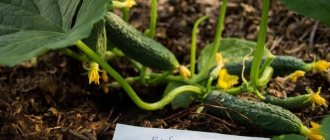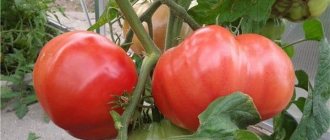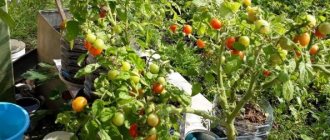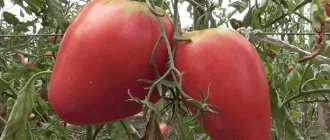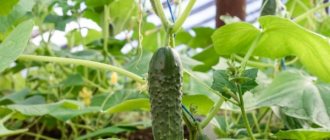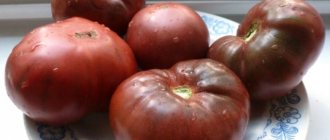The tomato variety “Babushkin Secret” was registered in the State Register in 2007 and is recommended for cultivation in greenhouses or open ground in all climatic zones of the country. Russian summer residents, who have been growing this variety of tomatoes for many years, speak very positively about it. Our article is intended to better acquaint gardeners with the plant and its properties.
Russian summer residents, who have been growing this variety of tomatoes for many years, speak very positively about it
The main characteristics of the variety are given in the table:
| Parameter | Characteristic |
| Culture | Tomato (Solanum lycopersicum L. var. lycopersicum) |
| Ripening period | Mid-season |
| Period from germination to fruiting | 110-115 days |
| Marketable yield | 16.9 kg/m2 (under film covers); up to 3 kg from 1 bush |
| Fruit weight | Average 354 g (maximum – up to 700 g) |
| Form | Flat-round, ribbed |
| Coloring of ripe fruits | Pink |
| Skin | Thin |
| Pulp | Thick, sugary, juicy, aromatic |
| Number of slots | More than 6 |
| Taste qualities | Excellent |
| Transportability and keeping quality | Low |
| Purpose | Salad, suitable for processing into juice |
| Plant type | Indeterminate, tall (up to 100 cm in open ground, up to 150-200 cm in greenhouses) |
| Leaves | Large, dark green |
| Inflorescence | Simple |
| Features of cultivation | Requires staking and plant formation |
| Disease resistance | The variety is weakly resistant to pathogens of major crop diseases |
| Recommended growing regions | All regions (in open ground and under film covers) |
| Year of registration in the Federal State Budgetary Institution "State Varietation Commission" | 2007 |
| Originator | Postnikova Tatyana Nikolaevna |
Characteristics and description of the variety
The mid-early variety reaches technical ripeness 115-125 days after emergence. Some gardeners claim that the cultivar will ripen later. In this case, you need to take into account growing conditions, temperature, and soil quality. In poor soils and cold summers, tomatoes may actually ripen later.
The plant is an indeterminate plant with a height of 1.5 to 1.7 m. According to reviews from vegetable growers, a bush in a greenhouse can reach greater heights due to the lack of an end point of growth for indeterminate plants. Therefore, it is recommended to pinch the top point after forming the 8th brush.
The tomato has a powerful stem, but due to its tallness it requires mandatory support.
For high yields and large fruits, the tomato bush must be pinched, growing into 1, 2 or 3 stems.
Grandma's secret belongs to the category of beef tomatoes. This means that the fruits of the variety are not only large, but also fleshy, without a hint of wateriness.
Tomatoes are round, flattened on both sides, and have pronounced ribbing at the stalk. When fully ripe, the skin acquires a red-crimson color.
The skin of tomatoes is thin, barely noticeable when eaten. When cut open in the photo, you can see that the tomato contains few seeds and has watermelon-type pulp. The fruits taste aromatic and sweet.
When properly cultivated, Grandma's Secret produces giant tomatoes weighing up to 1 kg. The largest ones, as a rule, form on the lower hands. The smallest fruits, according to the manufacturer, gain a mass of at least 300 g.
Productivity under closed ground conditions reaches 5.5-8 kg per bush. From 1 sq. m. harvest up to 16 kg.
The harvest is sold for the preparation of salads and tomato juice, which is very tasty and thick from this variety.
Reviews from summer residents about “Grandma’s Secret” tomatoes
Lydia, 29 years old, Omsk region
I grew “Grandma’s Secret” in a greenhouse, growing the bushes into two stems. On the lower clusters, some fruits weighed 550-600 g. The tomatoes were very meaty and tasty. They were good in salads, I liked the juice too.
One drawback: some had to be removed brown; they ripened in the house, but hard greenish veins remained in the pulp. I will still plant more. Now we have our own seeds, and the yield is satisfactory.
Nadezhda, 43 years old, Nizhnekamsk
The variety is productive, the fruits are tasty, large and beautiful. On the lower hands I had 400-500 g, on the upper ones it was smaller. The ripe ones, however, were not stored at all; some of them had to be processed into sauces. There were no particular problems with growing in a greenhouse. I tied it up, watered it carefully, at the root (I was afraid of late blight).
Nikolay, 56 years old, Moscow region
I’ve been planting the variety for four years now, several plants each in a greenhouse and in the OG (seedlings in a warm bed under a film on the arches). In the greenhouse, the harvest is always decent: the tomatoes are large and ripen well on the bushes. In OG, the result very much depends on the weather: in hot summers, the fruits ripen no worse than in shelter, but if August is cool and damp, the bushes are severely affected by late blight (preventative treatments hardly help).
I'm still happy with the variety. The germination rate of the seeds is high (they were originally purchased from the Siberian Garden, now I’m sowing my own), and the survival rate of the seedlings is also high. The fruits are large, tasty, and there are quite a lot of them. I will plant next season too.
Maria, 32 years old, Kursk region
The characteristics of the Grandma's Secret tomato are excellent; I bought the first seeds on the advice of a friend. I grew some very tasty salad tomatoes. Juiciness, aroma - everything is as it should be. In the greenhouse, the plants stretched up to 2 meters, the fruits weighed 330-400 g, but almost all of them ripened on the bushes. I had to tie it up and spray it against late blight, but I didn’t notice any other unnecessary worries. Next year I will sow my seeds.
Sowing dates and growing seedlings
For mid-early varieties, plant 60 days before moving the seedlings to a permanent place. When growing tomatoes in open ground, seeds are planted in the first ten days of March. When kept in a greenhouse, sowing work can be carried out at the end of February.
The timing of sowing depends not only on the place of cultivation, but also on the region. Southerners plant tomatoes as seedlings as early as February. For northern regions, especially if the tomato will be cultivated in open ground, early planting is not recommended. Otherwise, by the time of planting, the seedlings will outgrow or become very elongated.
Before sowing, the seeds are soaked for 1-2 hours in a Fitosporin solution. After disinfection, the planting material is soaked for half an hour in any growth stimulator (Epin and its analogues). The manufacturer himself advises carrying out this procedure. This will speed up the germination process and contribute to the formation of immunity in future seedlings.
After the preparatory procedures, the grains are slightly dried and planted in seedling containers filled with soil.
As a substrate, especially for beginners, it is advisable to use special soil for seedlings. It contains all the necessary substances that seedlings need for full development.
Grandmother's secret seeds are planted at a distance of 1-2 cm from each other, embedded in the ground to a depth of approximately 1-1.5 cm. Afterwards, the seedling containers are covered with film and put away in a warm place. The optimal germination temperature is from +23 to +25 degrees.
Check soil moisture daily. It shouldn't dry out. If necessary, the substrate is moistened with a spray bottle.
As soon as the first seeds hatch, the shelter is removed and the seedling containers are moved to a light source. Seedlings planted in February must be illuminated.
After the formation of the first pair of true leaves, the seedlings are planted in separate containers. 1-2 weeks after the procedure, Babushkin Secret tomatoes are fed with complex mineral fertilizer for seedlings with a high nitrogen content.
10-14 days before moving the tomatoes to a permanent place, similar conditions are created for them in which they will grow until the end of the growing season. To do this, seedling containers are taken out into the open air, veranda or greenhouse.
In the first days, the hardening time should be no more than 10 minutes. Then it is gradually increased. The night before planting, the seedlings are left on the veranda or greenhouse.
Tomato variety Grandma's secret on video
If you grew Grandma's Secret tomatoes, please write whether you liked them or not. What was the yield and taste of the fruits in your climatic conditions? How do you rate the disease resistance of this variety? If possible, attach a photo of the entire bush or individual fruits you grew. Thank you!
Your reviews of the Grandmother's Secret tomato, as well as additions to the description, will help many gardeners evaluate this variety more objectively and decide whether it is worth planting or not.
More than 1,600 varieties of tomatoes with photos, descriptions and reviews from gardeners in our Tomato Catalog.
Care in open ground and greenhouse
Tomatoes are planted in the ground when the ground warms up to +10 degrees and the air temperature does not drop below +12.
For 1 sq. m. The manufacturer of the Babushkin Secret variety recommends placing 2 to 3 tomatoes.
When planting, starting fertilizers are placed in the hole. Pegs are immediately placed next to the bushes to which the plants will be tied.
Like all large-fruited varieties, Babushkin Secret tomatoes require frequent but moderate watering. Their number can be reduced by mulching the root space of the bushes.
After the tomatoes put out the second brush, they are fertilized with complexes with a high content of phosphorus, calcium and potassium. These elements are necessary for the crop to form healthy, tasty and large fruits.
During this period, plants need less nitrogen. But you shouldn’t completely exclude it from the diet - the element is responsible for the health of the leaf apparatus and the supply of other necessary substances to the fruit.
The stepsons of the Babushkin Secret tomato variety are removed as needed. The plant is formed into 2-3 trunks.
When growing in a greenhouse, gardeners often plant more densely than in open ground and plant tomatoes in one trunk.
Further care
After planting seedlings in a permanent place, it takes time to settle down. This takes several days, then the bushes begin to grow actively. The variety has active shoot formation, so the shoots are removed regularly, especially at the beginning of cultivation. Carrying out pinching reduces the load on the bush and immediately serves as a good foundation for future productivity. In addition to pinching, plants are cared for as follows:
- Water the soil regularly. Watering should be at least 1-3 times a week, depending on the conditions of the region. The drip system is well suited for tomatoes; it is convenient to use and economical in water consumption;
- Hill up and weed the bushes for better plant development. Hilling has a good effect on further fruiting, and weeding reduces the risk of contracting tomato diseases;
- tie the stem to a support or trellis. The tomato bush should not lie on the ground, otherwise the ovaries will form poorly. The garter is carried to the very top of the head so that the stem stretches to its full length;
- fertilizers are used. Grandma's secret is responsive to the use of fertilizers, so it needs to be fed several times a season. Mullein, chicken droppings, stove ash, and green fertilizers on the grass are suitable for feeding. You can use ready-made complexes or mineral fertilizers. The frequency of fertilizing should be once every 10-15 days, and the quantity should be 3-4 times over the entire growing period.
During fruiting, watering is reduced and fertilizing is not carried out so as not to spoil the taste of the fruit. Tomatoes ripen on the branches together, so they need to be collected less than once every 2-3 days. Overripe tomatoes break the bush, and the development of new tomatoes occurs very slowly. Grandma's secret is not recommended for long-term storage, so tomatoes immediately after harvest are used for food or for making preparations.
Resistance to diseases and pests
The variety, according to the manufacturer, is resistant to TMV, powdery mildew and late blight.
Like other cultivars, Grandma's Secret is not immune to pest attacks. In the greenhouse these are spider mites, aphids, and whiteflies. In open ground, tomatoes can be bothered by mole crickets and the Colorado potato beetles.
At the first signs of pest damage, insecticide treatment is carried out. When infected with spider mites, drugs with an acaricidal effect are used.
Harvest and storage
As the fruits ripen, they must be removed from the stems to prevent overripening and cracking. This product is not suitable for long-term storage and transportation, so it is better to use it for salads, as well as for canning. Grandma's secret makes excellent tomato juice, adjika, homemade ketchup and pickles. Tomatoes of the Babushkin Secret variety do not require additional knowledge and skills at all. For the basic care that any plant needs, they will fully reward you with a high-quality, abundant harvest.
Advantages and disadvantages
Those who planted the Babushkin Secret variety highlight not only its advantages, but also its disadvantages.
pros
Large, sweet and sugary fruits.
Few seeds, dense pulp.
With feeding and proper formation, you can grow record-breaking tomatoes up to 1 kg.
Has immunity to fungal diseases.
You can collect your own seeds for planting.
Minuses
Tomatoes tend to crack, which is why they quickly become moldy.
Low yield in open ground.
Poor transportability due to thin skin.
Also, according to some gardeners, the Grandmother's Secret tomato has dryish flesh. According to them, the tomato lacks juiciness. Others consider this feature of the variety to be an advantage. Therefore, the dense, non-watery structure of the pulp can be attributed to both the advantages and disadvantages of this tomato.
Description of fruits
The fruits of the Babushkin Secret variety are very impressive. When ripe, they are large in size and pink in color, flat-round in shape and pronounced ribbing. The weight remains at approximately 350 grams, but under favorable conditions it reaches 700 grams.
The skin of the fruit is thin and glossy. The pulp is quite dense, it has a rich taste and a characteristic tomato smell. It is meaty and not too watery, some even find it dry. There aren't that many seeds. At the same time, the seed chambers themselves are small, there are at least 6 of them.
The taste is wonderful, but to enjoy it, you have to wait for the tomatoes to fully ripen. If you want to grow a fruit weighing a kilogram, then you need to strictly limit the number of stems and leave only one flower in the cluster. Also, for this, the crop needs careful feeding.
According to official descriptions, tomatoes are recommended for fresh consumption; they are suitable for raw salads and sandwiches. When heat treated, the fruits do not lose their quality. They are good for soups and main courses. Preservation is acceptable if the tomatoes are chopped. You can make tomato paste. Some housewives make juice from them, but harvesting on a large scale is impossible.
Similar varieties
According to the description of the variety, the Babushkin Secret tomato has several analogues:
- Miracle of the Earth tomatoes are mid-season. The fruiting period begins after 110 days. The crop is tall, reaching 2 m in a greenhouse. Ideal for growing in Siberian regions in closed ground. Productivity per sq. m. does not exceed 14 kg.
- Superbomb is a medium-late cultivar that ripens 120 days after germination. With proper cultivation, large fruits weighing up to 600 g ripen on the bush. The yield promised by the manufacturer is 7 kg per plant.
- The Khlebosolny variety rarely exceeds a height of 0.9 m. It often stops growth at 0.7-0.8 m. Fruit ripening dates range from 110 to 115 days. Like Grandma's Secret, it is recommended for cultivation in Siberia and the Urals. Productivity – up to 5 kg per plant.
- The Mammoth tomato is a mid-early cultivar with large crimson fruits of a slightly flattened shape. Tomatoes up to 600 g or more. The yield per bush, like Grandma’s Secret, is on average 5.5 kg. Tall tomato, grows up to 2 meters in height.
Main characteristics
This is a variety of unlimited growth. It is a typical large-fruited salad tomato. Under growing conditions in protected soil, the height of the bushes reaches 2 meters, in beds - 1 meter. The stem is not so powerful, it is distinguished by moderate formation of shoots and average foliage. The leaves are the most common size, tomato type, dark green in color, slightly wrinkled. The inflorescence is of a simple type, up to 8 of them are formed on the main stem, each with about 5 ovaries, sometimes more.
To ripen large tomatoes, experts recommend leaving only 2-3 flowers. The ripening period of tomatoes is about 110 days from the moment the first shoots appear.
How to care for tomatoes
After two months, the seedlings are ready to be transplanted to a permanent location . Overgrown seedlings take a long time to take root after being placed in the ground, so you need to place the tomatoes in the garden bed in time.
Landing
The soil is dug up and a full range of minerals is added . Then pour a hot solution of dark manganese. The holes are made at a distance of 60 cm from each other, placing them on 1 square. m 3-4 seedlings.
Reference! A strong stem is an indicator of healthy and hardened seedlings.
The bushes are installed vertically and buried to the first leaves. After transplantation, the holes are compacted and watered with warm, settled water.
Further care for tomato Grandma's secret
They begin to water regularly when the seedlings take root in a new place . Do not water abundantly as the soil dries out. The beds should not be over-watered, as this will affect the taste of the fruit: they become watery.
After watering, weeding and loosening are required . Loosening the beds will improve air permeability, and removing weeds will retain in the soil many of the beneficial substances necessary for tomato growth. Mulching beds retains moisture longer and prevents the appearance of ground-based pests. In addition, mulch prevents weeds from growing.
Reference! Straw, sawdust or peat are most often used as mulch.
Fertilizers include a full range of minerals or organic matter . Judging by reviews from gardeners, powerful bushes grow exclusively from fertilizing with mullein and bird droppings. These organic compounds also affect the taste of the fruit, making it richer and the tomatoes themselves meatier.
When fertilizing with minerals during flowering, phosphorus is used , and at the time of fruiting they are fed with potassium for accelerated ripening.
Features of care and possible difficulties
From the photo and detailed description it is clear that tall plants need a garter . The support is installed when transplanting seedlings. After planting in the ground, the stem is immediately fixed to the support, otherwise it will form weak and uneven. Fruit-bearing branches are also tied to the supports, since they cannot withstand the weight of large fruits. Wooden stakes or metal rods are used as support.
Form a bush into one stem , removing all other stepsons. When the eighth flower cluster appears, the main stem is pinched, limiting growth. Thus, all forces are spent on the formation of ovaries.
Pruning is carried out regularly to prevent the plantings from becoming dense. For the same reason, unnecessary leaves are removed, especially the lower ones. In addition, if they come into contact with wet beds, they can rot and become a source of fungal infections.
Diseases and pests
The main danger for the crop is the fungal infection late blight. This is a common disease of the nightshade family that can cause great harm to plantings. To combat it, use the systemic fungicide “Fitosporin”. But with regular preventive measures, seedlings can be protected from infection.
Such measures include:
- moderate watering with humidity control;
- systematic loosening;
- weed removal;
- mulching beds;
- ventilation of protected structures;
- spraying plants with fungicidal agents;
- feeding to strengthen the immune system.
If you follow agrotechnical practices and crop rotation rules, the seedlings do not get sick and bear fruit for a long time.
Whiteflies and Colorado potato beetles pose a particular danger to tomatoes . To prevent whiteflies from entering your beds, plant calendula or marigolds next to the tomatoes, the smell of which repels the pest. Spraying plants with a decoction of onion peels also helps. The Colorado potato beetle is collected manually, and when there is a large accumulation of it, the chemical preparation “Prestige” is used.
To prevent the development of infections and pest invasions, seedlings are regularly carefully inspected for changes.
